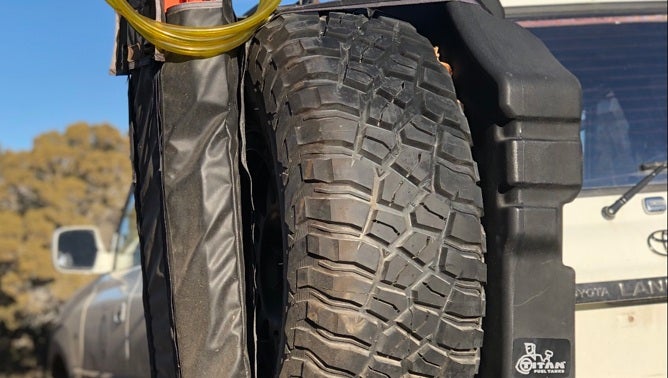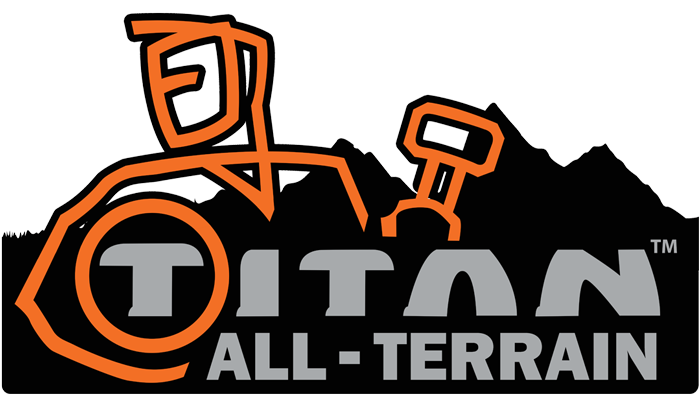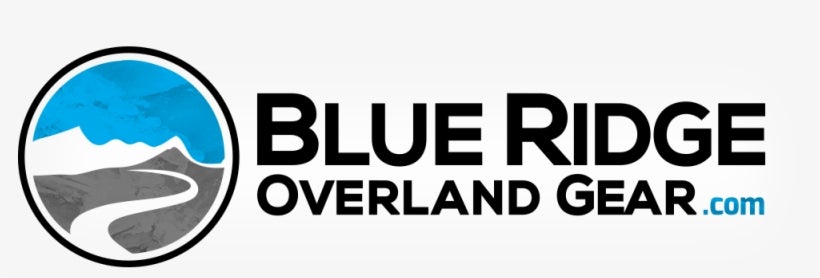The Titan Trail Trekker II makes significantly expanding your off-road vehicle’s range easier and more convenient than any other method we’ve tried…and we’ve tried them all. Check out our long-term review of the Titan Trail Trekker II below to see how and why it works.
Exploring remote country requires planning and self-sufficiency in spades. For many, a trip’s enjoyment is equal parts doing and preparing. Despite careful planning, fuel usage often goes awry. Interesting side trips, detours or encountering motorists short on gas will rapidly leave you calculating the miles until empty. This dilemma (coupled with poor fuel efficiency) has made the old Jerry can an icon of 4x4s.
Derived from military surplus, metal Jerry cans may look the part, but are fraught with problems. Rust, leaking hoses, problematic mounts and bulk are chief among concerns. Their high quality cousins – Wavian and NATO versions – offer significant improvements in some respects, but are essentially no different. A true alternative emerged with Rotopax rotationally molded fuel containers, which added durability plus stacking and locking. Each of these options has its place, and all are simple, portable solutions.
While I own each of those containers, and appreciate their strengths, I’ve always found that what I need is fuel storage which stays on my truck, stays off the roof, and doesn’t get removed (i.e., left at home). Although Toyota offered an auxiliary tank that can be mounted under the rear floor of our Land Cruiser, the cost and complexity of that solution has never held much appeal. What I wanted instead was a foolproof means to subtly store 10-15 gallons of extra fuel, and to mount it as low as possible.
Surprisingly, the off-road specialty manufacturers haven’t provided many options for carrying fuel in something other than individual 2-5 gallon cans. For pick-ups the problem is less significant thanks to in-bed tanks. For SUV’s the obvious solution has been spare tire carriers, which themselves are engineered to handle significant loads. However, most solutions fall back to cans or other containers. Only one manufacturer has recently marketed a solution, and it forces you to purchase its swing arm system…and only works with a certain 5-bolt lug nut pattern.
Table of contents
The Titan Fuel Tanks
Leave it to a dedicated fuel tank company to fill this niche. Titan Fuel Tanks of Idaho Falls, Idaho began manufacturing Made in the U.S.A. tanks in 2003. Exclusively using military grade XLHDPE – Cross-linked High Density Polyethylene – instead of the typical linear polyethylene, Titan products significantly increase durability, including impact resistance, through their designs. Originally created to serve the needs of diesel owners seeking to add range, Titan has expanded into the OHV and 4×4 markets with a range of products under Titan All-Terrain. Today, Titan All-Terrain offers a line of UTV tanks, along with the Trail Trekker II, their first off-road product focused on 4x4s.
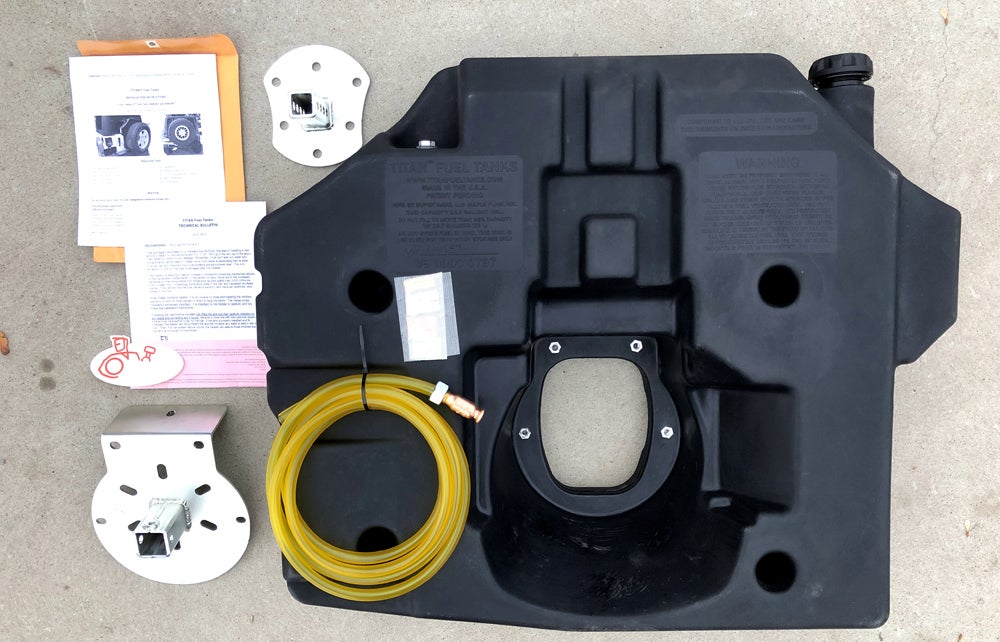
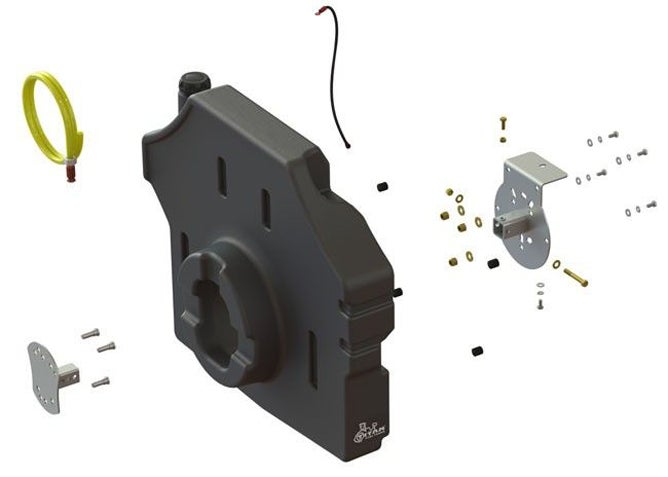
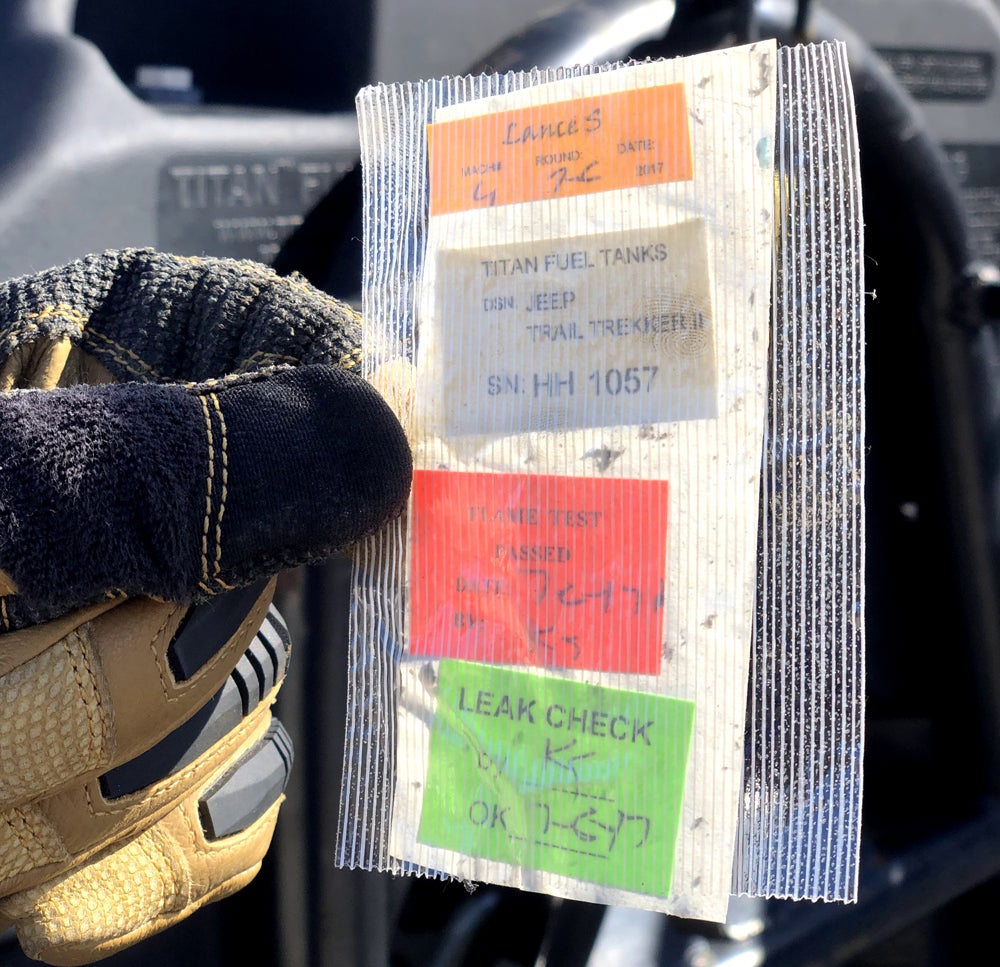
Created to mount on the spare tire of an SUV or pickup that uses either a factory or aftermarket rear mount, the Trail Trekker II enables both fuel and the spare tire to be securely mounted. Because it is offered in configurations for 5, 6 and 8 lug bolt patterns, the Trail Trekker fits most 4×4 spare mounts. In addition, unlike other designs, Titan made the tank compatible with spare tires mounted on rim diameters as small as 15”.
The other distinct advantage that Titan integrated was maximum fuel capacity. You would need three NATO cans to match the volume the Trail Trekker holds. Its conservative 12-gallon (45L) capacity makes it the largest 4×4-oriented external tank offered in North America. For comparison, the AEV Fuel Caddy (intended only for Jeep Wranglers) holds 10.2 gallons. To have more capacity you’ll need to permanently mount an auxiliary tank under your vehicle. High quality auxiliary tanks, such as GenRight or Long Ranger, can set you back $1,500 to $2,200 for the tank alone. If you can locate one to fit your vehicle, be sure to plan on several hours for the install, wiring, plumbing and such.
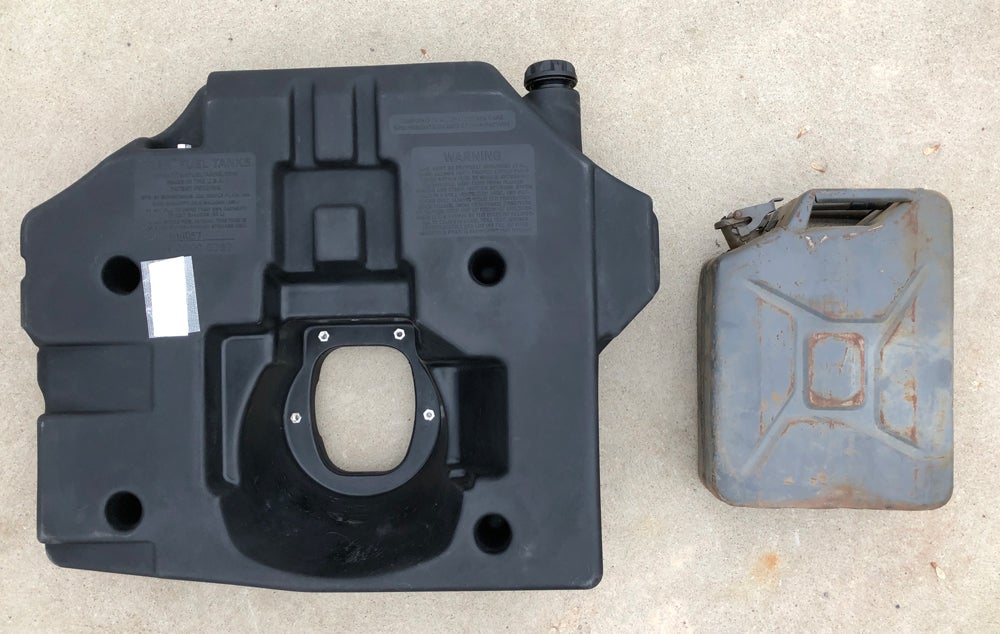
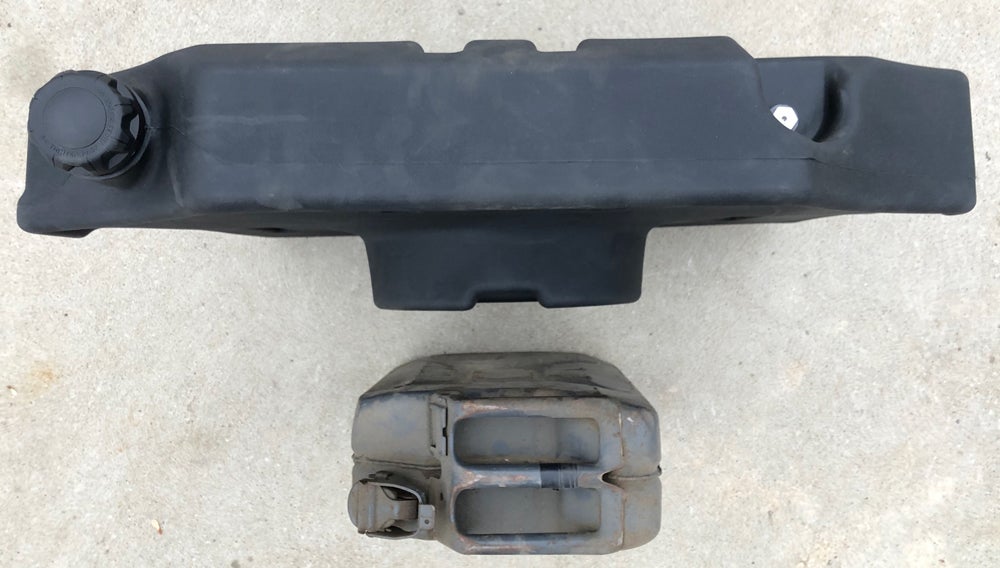
For most users, the added capacity of permanently mounted auxiliary tanks isn’t worth the significant costs and complexity. Unless you are focused on routinely exploring Australia or similarly vast, unpopulated lands (or simply want to outfit your rig like it is) those tanks are excessive. Even in America’s relatively remote desert Southwest where we explore, a 12-gallon fuel buffer offers plenty of peace of mind, increasing range on most vehicles by 50%.
Furthermore, the Titan Trail Trekker holds more fuel than what Titan quotes. The capacity stamped on each tank is 14.4 gallons, with the maximum recommended fill amount being 13.7 gallons. Conservatively speaking, that will add 150 more miles to even the thirsty Land Cruiser’s range, which will get you from the Dollhouse #2 campsite to Hanksville, UT if exploring the remote Maze District of Canyonlands National Park.
Titan Trail Trekker II Installation
The Titan Trail Trekker II was designed to interface between most tire carriers and the spares they support. While the tank itself is rigid and durable, a welded stainless steel bracket bolts to the tank via five molded inserts. The bracket’s broad, lower flange supports the mass of the tank, directing it onto the spare tire mount. The bracket itself bolts to the existing studs for the spare tire mount, while incorporating a new mounting flange on which the spare is bolted.
Titan provides detailed instructions explaining how the provided wheel studs are to be pressed in to match your bolt pattern. This and other instructions are clear and detailed in their descriptions, and are accompanied by easily understood illustrations. Because any fuel storage product carries inherent safety risks, the Trail Trekker comes with an additional packet of instructions and warnings related to its proper usage, fuel considerations, etc. Tanks undergo multiple safety checks to certify quality.
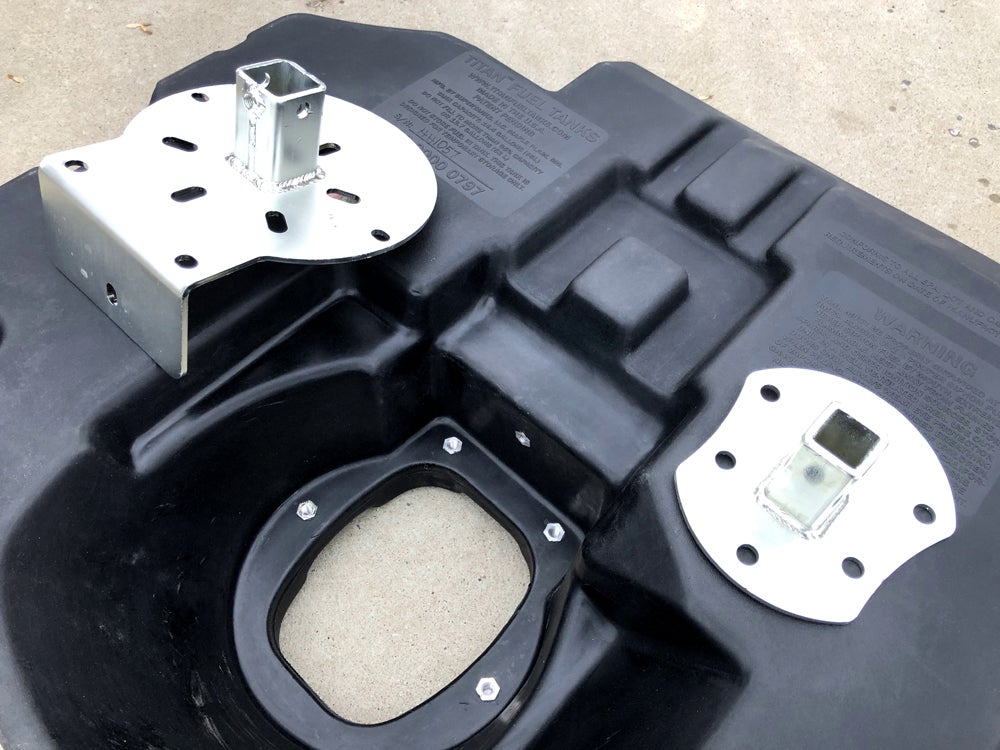
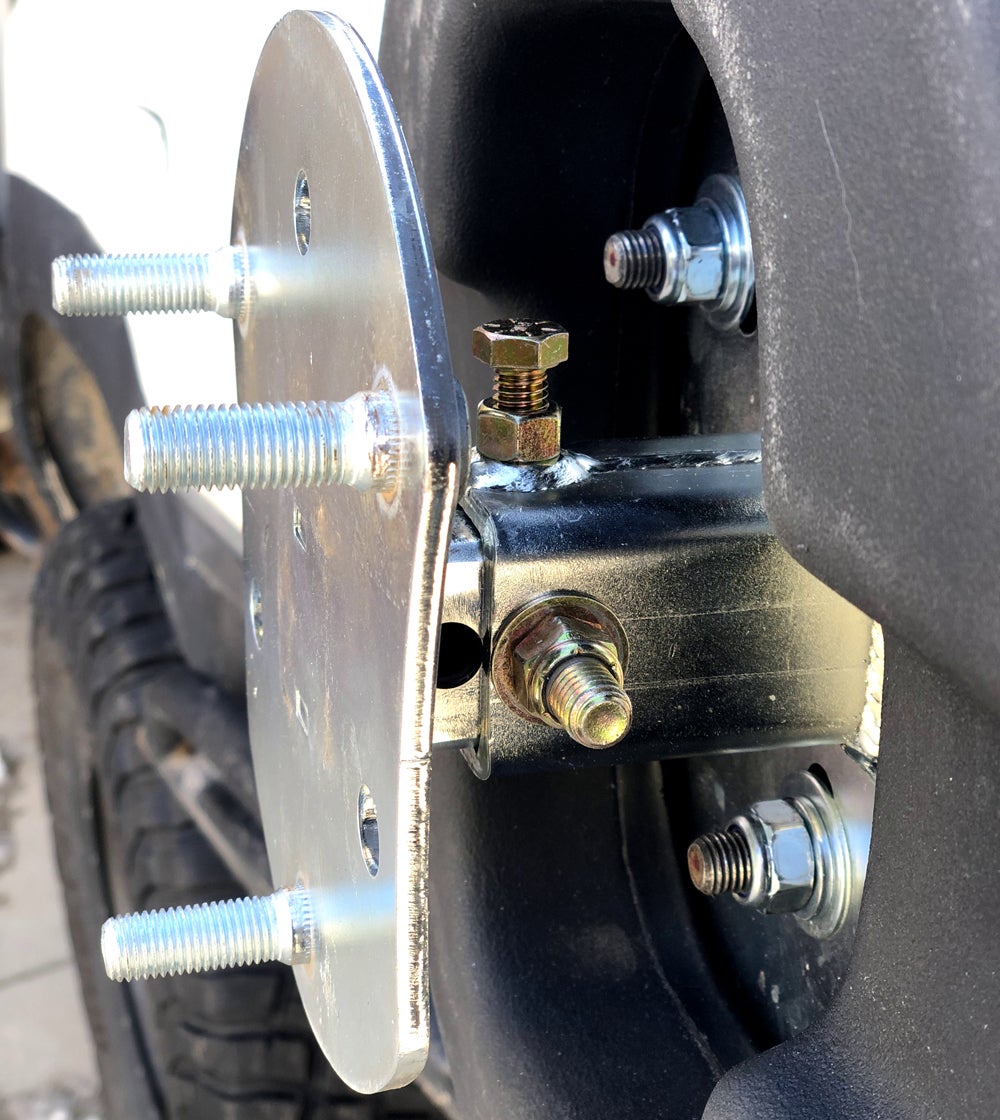
Key among the safety steps related to installation is assuring that the tank is grounded. Grounding isn’t provided in some fuel storage systems, but Titan includes all that’s needed in with the mounting kit, along with the steps for the ground’s installation.
Total installation time for the Titan Trail Trekker II was, in our case, ~2 hours. This was based on one person working at a leisurely place, and including some adjustments to the Cruiser’s Iron Pig rear bumper. Not included was the relatively time-consuming step of upgrading the bumper’s worn spindles. Spindles that carry the load of even basic items, such as a spare tire or Hi-Lift, undergo significant stresses. Adding the burden of 100+ lb of fuel tank can double that strain. To upgrade the strength of the Iron Pig swing-out spindles we turned to NorthWest Fabworks, a British Columbia-based company that has built its reputation on CNC solutions for the offroad community (see Sidebar).
Assuring a firm fit of the tank against the swing arm’s frame is the key to preventing vibration and wear. This also means measuring the mounting flange and tank clearance so that there isn’t an excess of pressure against the 5 bolts that secure the flange to the tank’s inset nuts.
When it comes to mounting, a wide array of popular aftermarket tire carriers are listed as confirmed figments according to Titan. In our case, mounting to an Iron Pig Offroad tire carrier posed no problems. To obtain a secure fit, some trial-and-error was necessary, however, as it will be with each different configuration. Ultimately, a snug fit is the goal, thus eliminating vibration and movement that can impact components.
Integrated venting on the Titan Trail Trekker II responds automatically to pressure changes. A cap keeper prevents dropping it in the dirt, and leakage from extreme angles or rollover is prevented by secure seals. With a lifetime warranty, the Trail Trekker is backed by Titan, and is clearly designed to last.
Upgrading Your Swing Arms
At 6.3 lbs per gallon, gasoline in the Titan Trail Trekker can weigh 86 pounds, with a full container adding 117 pounds to the mount. Coupled with a large spare tire of similar weight, the resulting mass places a significant load on swing arm systems. Planning for that load means assessing the flex occurring in a spare tire mount prior to adding the Trail Trekker. In our case, long-term wear had degraded the fit of spindles on the Land Cruiser’s swing arms. The spindles’ brass bushing design does not self-adjust as wear occurs, which with time resulted in gaps and, ultimately, movement throughout the armature.
NorthWest Fabworks is a machine shop that produces a wide range of complex parts for off-road applications. It’s fair to say that the company’s spindle kit may actually be the simplest item it makes. Nonetheless, its precision and quality belies the lifespan and use its meant for. The lone spindle design it offers has gained respect for its hard-core construction. In comparison to competitors’ kits, which typically use 1.25-1.5” base material, the Northwest Fabworks spindle is substantially beefier. Its spindles are machined from 1-3/4″ diameter 1018 mild steel, and retain the majority of that mass throughout a much greater portion of the spindle. Smooth action is provided through dual 3500lb tapered roller bearings; many similar products either do not post their ratings or use lower rated bearings. The spindle and bearing system interfaces with the machined 2-5/8” x 4-5/8” 1020 DOM sleeve, to which is welded the swing out armature.
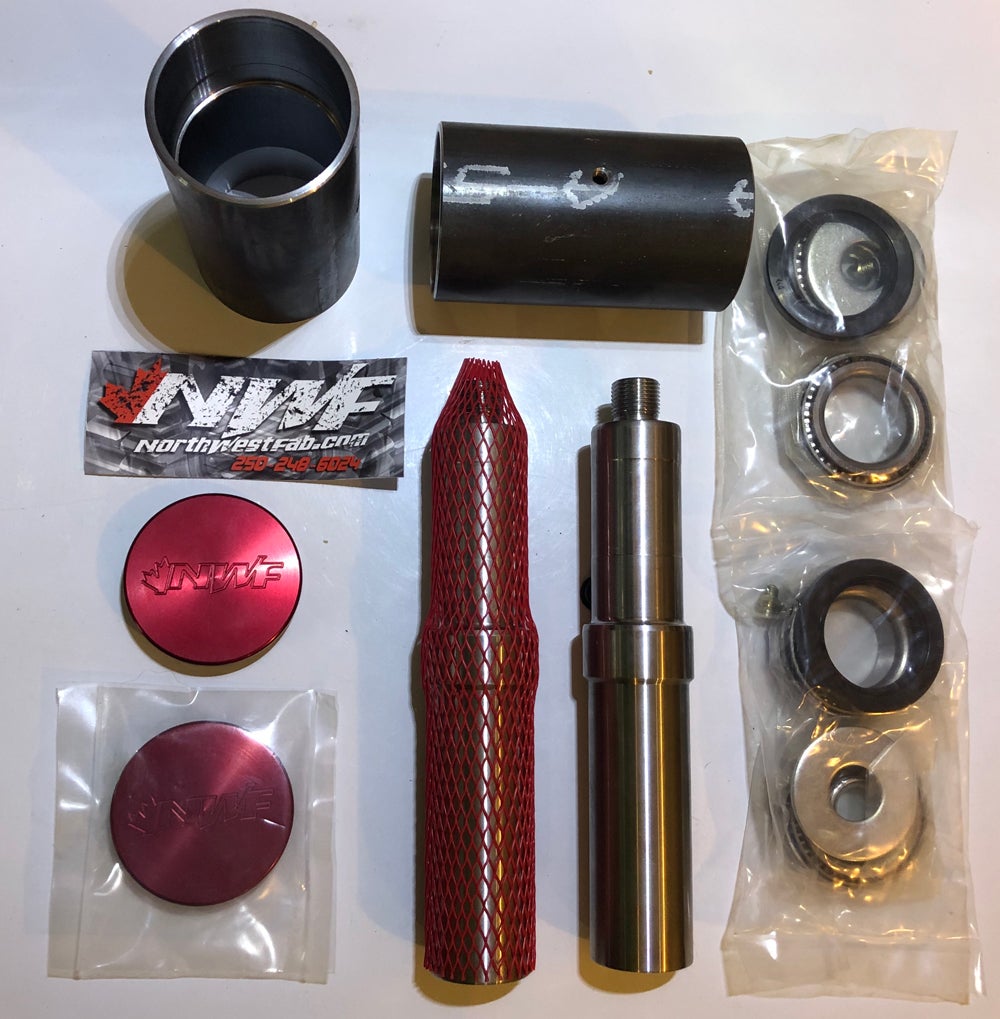
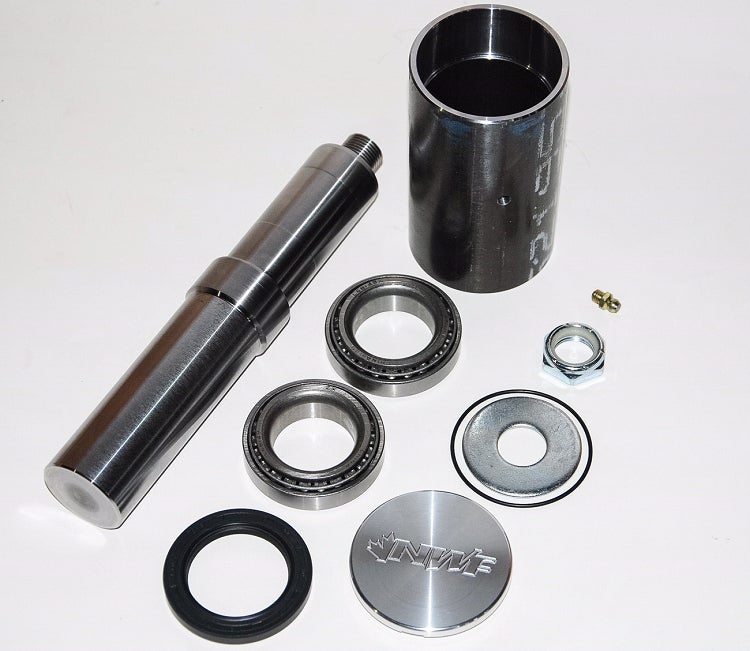
Incorporating a machined, engraved aluminum cap with anodized colors, along with a grease zirc for easy servicing, the NorthWest Fabworks system is stout and designed for a long service life under extreme conditions and constant heavy loads. In searching for a replacement for our bumper’s modest spindles, NorthWest Fabworks option was overall the most well-built and full-featured we found. As a bonus, the kit is also competitively priced at only $99 USD per kit (no additional charge for aluminum caps). These spindles offered a perfect complement to the combined mass our Cruiser carries with a fuel-filled Titan Trail Trekker and a 37” spare tire on a single swing out.
Using the Titan Trail Trekker II
Auxiliary fuel containers fail or succeed by how easily they transfer the liquid to your main tank. The Titan Trail Trekker II was designed for simple operations, relying on a siphon hose to gravity feed fuel. To help assure the provided siphon will suck the maximum fuel from the tank, a subtle pitch in the bottom of the tank means fuel finds its low point directly below the fill cap. This feature is helpful, and lessens the amount of fuel left in the bottom. In reality, it can be challenging to not leave a half gallon or more in the Trail Trekker. The challenge lies in the siphon itself.
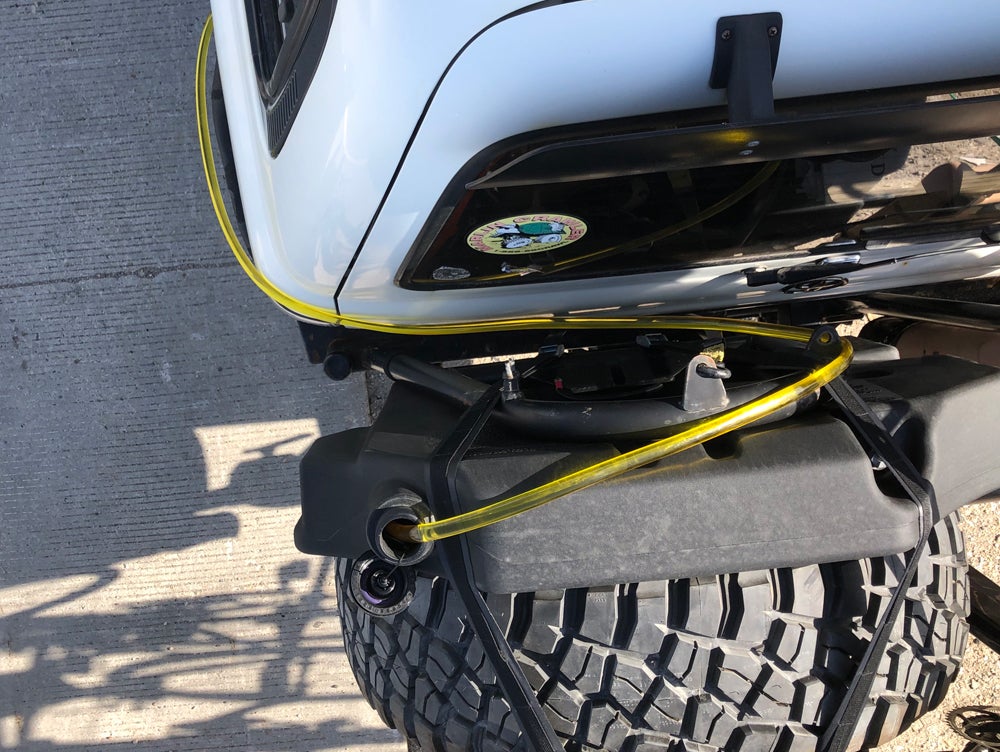
Siphons were popularized in the 1970’s when Australia’s Syphon Mate created, and then brought to America, their “shaker valve” hose. Derived from the ancient precedents (e.g., Chinese “jiggle syphon”), which employed a clay ball in a bamboo tube, today’s 4×4 siphons haven’t fundamentally changed, and enable fuel transfer from any elevated container into a vehicle fuel tank. Relatively foolproof, cheap and simple, one of those hoses comes with each Titan Trail Trekker II. Compact and safe, and requiring none of the hoisting and holding of portable fuel jugs, the siphon end of the hose is dropped into the Trail Trekker II until it reaches the bottom, the opposite end having been inserted into your vehicle’s fuel fill port.
Using a marble-like ball inside of a brass valve, shaker siphons require a vigorous up and down shaking of the hose to compel fuel to be moved up the hose. When it begins moving on its own, the fuel will, if higher than the opposite end, continuously flow, and soon produces a distinctly audible rattling of the ball valve as the gravity-drawn liquid steadily moves through. Hearing that sound (along with seeing the absence of air in the clear hose) confirms the siphoning has begun.
Once fuel is moving on its own, the key step is to assure the intake end of the hose rests at the lowest point in the Titan Trail Trekker II. Due to storing the hose in a coil, the curl of the hose can make it resistant to descending to that low point. This isn’t a significant problem, but does mean that some fuel may be left at the bottom of the tank.
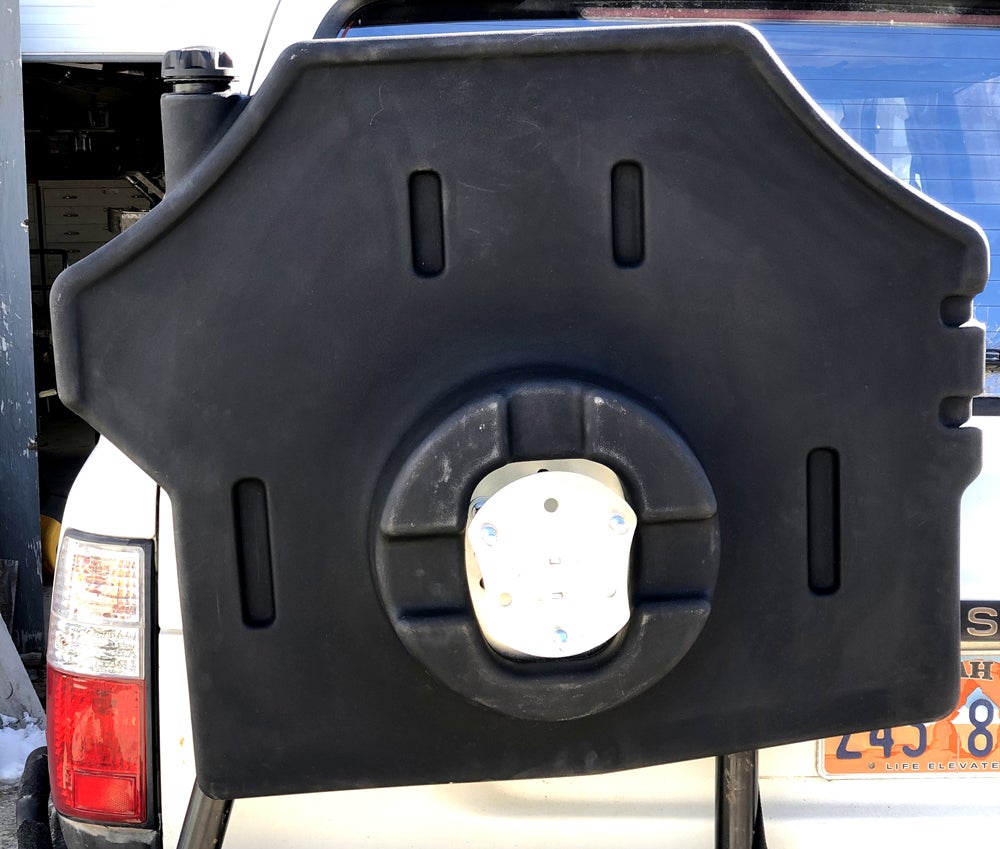
At the other end, the pliable nature of the hose when new means that some vent flaps on vehicle filler necks can compress the hose. Using a rigid insert in conjunction with the hose will help this tendency if your vehicle’s flap has an especially strong spring. A toothbrush (now forever retired) worked well for this solution when the hose was new and soft. With time, however, the hose has gained a bit of firmness, and now better resists collapsing from the filler flap.
Rated at 2gpm, the shaker siphon isn’t the fastest means for moving fuel, but the estimated transfer rate has proven to be accurate and more than adequate. In five minutes the Titan Trail Trekker can be mostly emptied, and the siphon hose can be lifted out to gravity drain any remaining fuel into your vehicle’s tank. Thereafter it’s helpful to have an exterior place to store the hose, as fumes from fuel will be given off as it air dries. Having a nearby, exterior storage container, such as Blue Ridge Overland Gear’s Tire Storage Bag, is handy as a place to stow the hose. Protected from dust (if kept in a large Ziploc) and protecting occupants from odors, these spare tire bags are situated conveniently next to the Trail Trekker II.
With all fuel tanks, venting related to pressure changes and off gassing should be a consideration. Some tanks rely upon tank flex for gas expansion, and thus incorporate no venting. Titan Tanks knows better from their long history in fuel storage. The Titan Trail Trekker II exhibits none of the nasty pressure release exhibited by metal fuel cans when you pry their lids open on a hot day (or resistance to opening when harboring negative pressure after cooling). The Trail Trekker II vent cap is easily opened and enables continuous equalizing of pressure. Easily large enough for gas or diesel nozzles, the opening is near the high point for the tank, thus assuring a portion of the tank has an air cavity.
Trip Planning with a Titan Trail Trekker II
Adding a Titan Trail Trekker II means your 4×4 always has the option of an abundance of fuel storage on hand. At only 31 lbs empty, its weight gain is negligible, being similar in weight per gallon of capacity to other fuel storage (e.g., Rotopax). However, its greater capacity means significant additional range is available. Or, if you prefer, a 50% safety margin is provided on top of your vehicle’s standard tank capacity. More than just helpful, that margin can be essential. For instance, the two factors that can most impact fuel efficiency are miles traveled in Lo Range and how much you tow a trailer. Each can cut fuel range by 30% or more, further adding to the necessity of carrying additional gasoline or diesel.
After adding the Titan Trail Trekker II to our rig, we’ve come to appreciate the peace of mind that a dozen gallons of back-up fuel brings. Not that pushing limits is a bad thing when one is product testing, but on most trips we’re not looking for trouble. But despite best intentions, in at least three instances the trips we were on in remote corners of the desert Southwest resulted in fuel range miscalculations. Although the orange dashboard light tried its best to issue a warning, the results were the same: sudden fading of power, spontaneous sweating, and embarrassment as we coasted onto the shoulder, 4-way flashers signaling “I screwed up.”
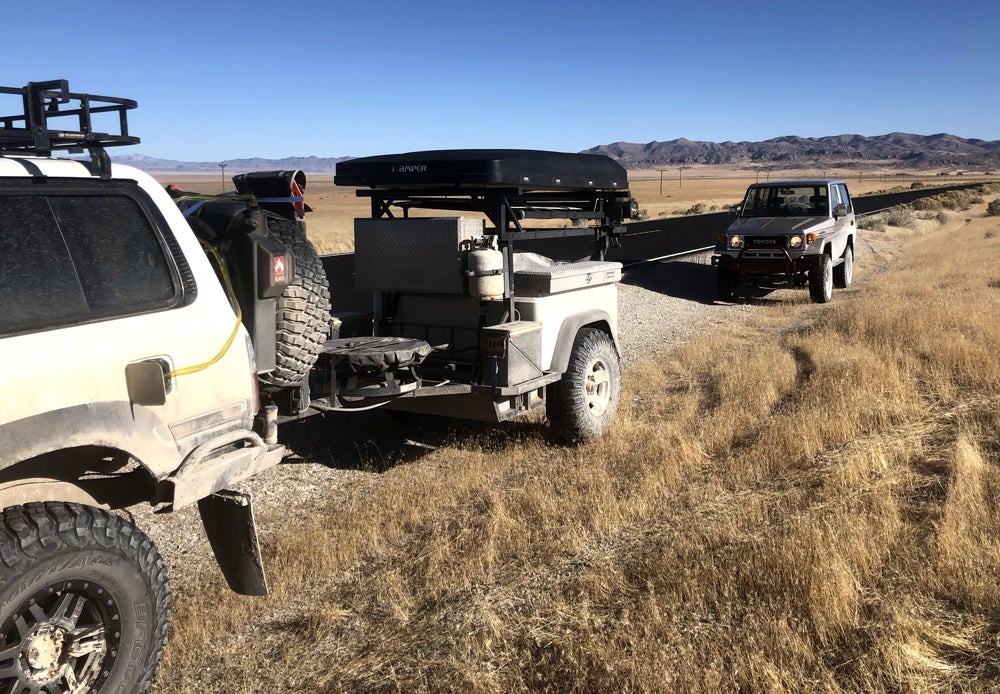
In times like these it’s best to throw it in Park, pull out a stopwatch app, and test the real-world field transfer of fuel. In one instance I stood next to roaring interstate traffic, passersby gawking as I timed the draining of the Titan Trail Trekker (<10min total). In another instance, I was facing a price gouging service station in some one-horse-town, and opted to fall back on the 12 gallons I had stored aft (which had been purchased at $.70 less per gallon). On the most recent occasion, I pulled off the asphalt in eastern Nevada’s vast Basin and Range country, the lone gas station lying a single tempting mile beyond where the Toyota died. In under 4 minutes I was again rolling, headed toward the elusive station, and smiling at how easy it was to siphon a gallon or two into the truck’s tank.
Though they don’t advertise it as an advantage, Titan Tanks has also made it easy and quick to provide road- or trail-side assistance to other vehicles in distress. Whether in your group or a stranger you come across, the Titan Trail Trekker allows you to help others in need. Requiring no lifting or heavy containers (a full NATO can weighs 42 lbs), or attaching of spouts that leak, the Trail Trekker makes such transfers simple. The drawback? A siphon doesn’t allow you to simply pour small or specific amounts. It will also keep flowing until the fuel runs out, or until you lift the low end of the hose to staunch the siphon effect. Nor does it allow the convenience of mobility.
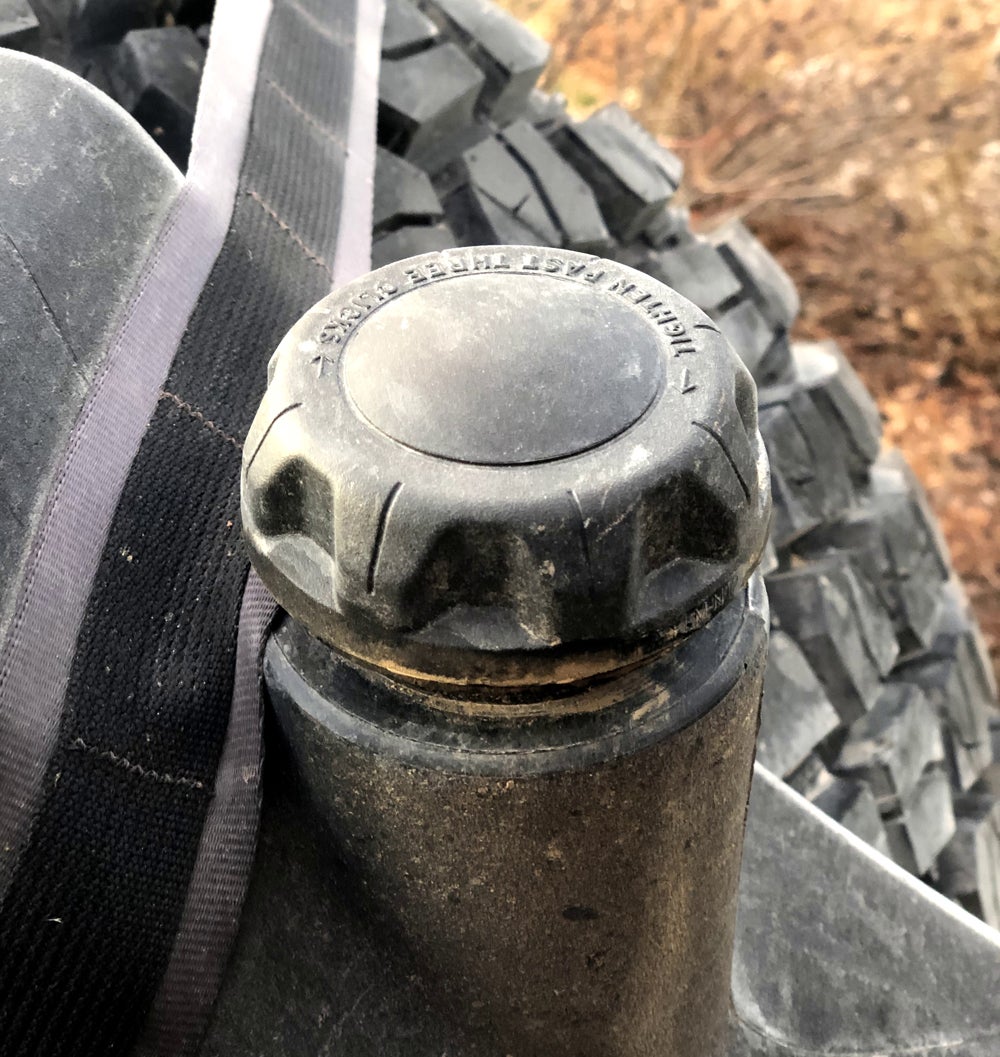
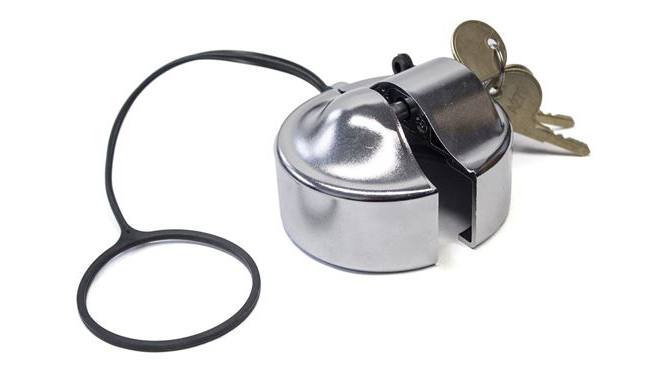
Does the ease of fuel transfer raise security concerns? While unlikely (depending upon where you travel), it’s simple to illicitly remove fuel from a Titan Trail Trekker II…if a thief has a siphon hose. This same criticism, however, can also apply to other containers. Titan Tanks, however, has a number of recommended solutions for this issue. Universal locking cap covers offer security solutions and are easy to remove.
Despite its venting and roll-over spill prevention features, the odor of gasoline fumes hasn’t been a problem, which is important with rear end access being how we reach food in the fridge. In fact, what has been most noticeable about the Trail Trekker is that you simply forget it is back there (at least until you move the loaded swing out). Before heading out on a trip you fill it up, and then proceed with peace of mind. Note: Titan Tanks provides a reminder that long-term storage is not an intended or approved usage. That said, we’ve added STA-BIL or Fuel Med RX to be sure that any forgetfulness did not result in degraded gas characteristics (30 days being the longest period to store gasoline without treatment added).
- Pros – Highest capacity auxiliary tank, using military-grade construction, that offers fitments for most bolt patterns; simple, low effort fuel transfer; lifetime warranty.
- Cons – Requires a rear-mounted spare tire carrier with sufficient strength; siphon hose must be properly stored to avoid dust or off-gassing; not portable; requires a separate locking cap to prevent fuel tampering.
- Bottom Line – The most affordable and simple solution for significantly expanding your vehicle’s range.
Our Final Verdict
Exploring in remote backcountry demands ample fuel capacity. Although a rack full of NATO cans on your roof rack may feel stylish, their mass presents a liability, and their location an inconvenience. Fuel, like water, should be situated as low as possible. Even mounted below the roof, Rotopax and other quality fuel containers are costly, offer limited mounting options, and carry with them the hassle and mess of pouring through a nozzle. The Titan Trail Trekker II has expanded the gas/diesel container market, and addressed the limitations of competitors’ products in the process. It’s a rugged Made in the U.S.A. fuel tank, with a well-executed design, and fitment options for countless 4x4s (and now UTVs). Though not the least expensive option, the Trail Trekker II is a welcome new addition, and worth a look by anyone wanting to lengthen the distances they can explore between fuel stops.
About the Gear Doctor: Dr. Sean Michael has been designing, abusing and testing outdoor gear since the 1980’s, and began reviewing for Off-Road.com in 2000. Today, he is Professor of Outdoor Product Design & Development at Utah State University, a product consultant, and a frequent Instructor at Overland Expo. Follow his trips and gear @thegeardoctor on Instagram.
